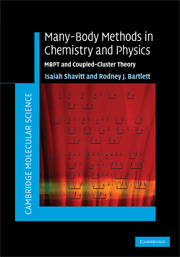Book contents
- Frontmatter
- Contents
- Preface
- 1 Introduction
- 2 Formal perturbation theory
- 3 Second quantization
- 4 Diagrammatic notation
- 5 Diagrammatic expansions for perturbation theory
- 6 Proof of the linked-diagram theorem
- 7 Computational aspects of MBPT
- 8 Open-shell and quasidegenerate perturbation theory
- 9 Foundations of coupled-cluster theory
- 10 Systematic derivation of the coupled-cluster equations
- 11 Calculation of properties in coupled-cluster theory
- 12 Additional aspects of coupled-cluster theory
- 13 The equation-of-motion coupled-cluster method for excited, ionized and electron-attached states
- 14 Multireference coupled-cluster methods
- References
- Author index
- Subject index
Preface
Published online by Cambridge University Press: 06 January 2010
- Frontmatter
- Contents
- Preface
- 1 Introduction
- 2 Formal perturbation theory
- 3 Second quantization
- 4 Diagrammatic notation
- 5 Diagrammatic expansions for perturbation theory
- 6 Proof of the linked-diagram theorem
- 7 Computational aspects of MBPT
- 8 Open-shell and quasidegenerate perturbation theory
- 9 Foundations of coupled-cluster theory
- 10 Systematic derivation of the coupled-cluster equations
- 11 Calculation of properties in coupled-cluster theory
- 12 Additional aspects of coupled-cluster theory
- 13 The equation-of-motion coupled-cluster method for excited, ionized and electron-attached states
- 14 Multireference coupled-cluster methods
- References
- Author index
- Subject index
Summary
“What are the electrons really doing in molecules?” This famous question was posed by R. A. Mulliken over a half-century ago. Accurate quantitative answers to this question would allow us, in principle, to know all there is to know about the properties and interactions of molecules. Achieving this goal, however, requires a very accurate solution of the quantum-mechanical equations, primarily the Schrödinger equation, a task that was not possible for most of the past half-century. This situation has now changed, primarily due to the development of numerically accurate many-body methods and the emergence of powerful supercomputers.
Today it is well known that the many-body instantaneous interactions of the electrons in molecules tend to keep electrons apart; this is manifested as a correlation of their motions. Hence a correct description of electron correlation has been the focal point of atomic, molecular and solid state theory for over 50 years. In the last two decades the most prominent methods for providing accurate quantum chemical wave functions and using them to describe molecular structure and spectra are many-body perturbation theory (MBPT) and its coupled-cluster (CC) generalizations. These approaches have become the methods of choice in quantum chemistry, owing to their accuracy and their correct scaling with the number of electrons, a property known as extensivity (or size-extensivity). This property distinguishes many-body methods from the configuration-interaction (CI) tools that have commonly been used for many years. However, maintaining extensivity – a critical rationale for all such methods – requires many-body methods that employ quite different mathematical tools for their development than those that have been customary in quantum chemistry.
- Type
- Chapter
- Information
- Many-Body Methods in Chemistry and PhysicsMBPT and Coupled-Cluster Theory, pp. xi - xivPublisher: Cambridge University PressPrint publication year: 2009
- 1
- Cited by



